Despite outreach, downtown homeless population growing
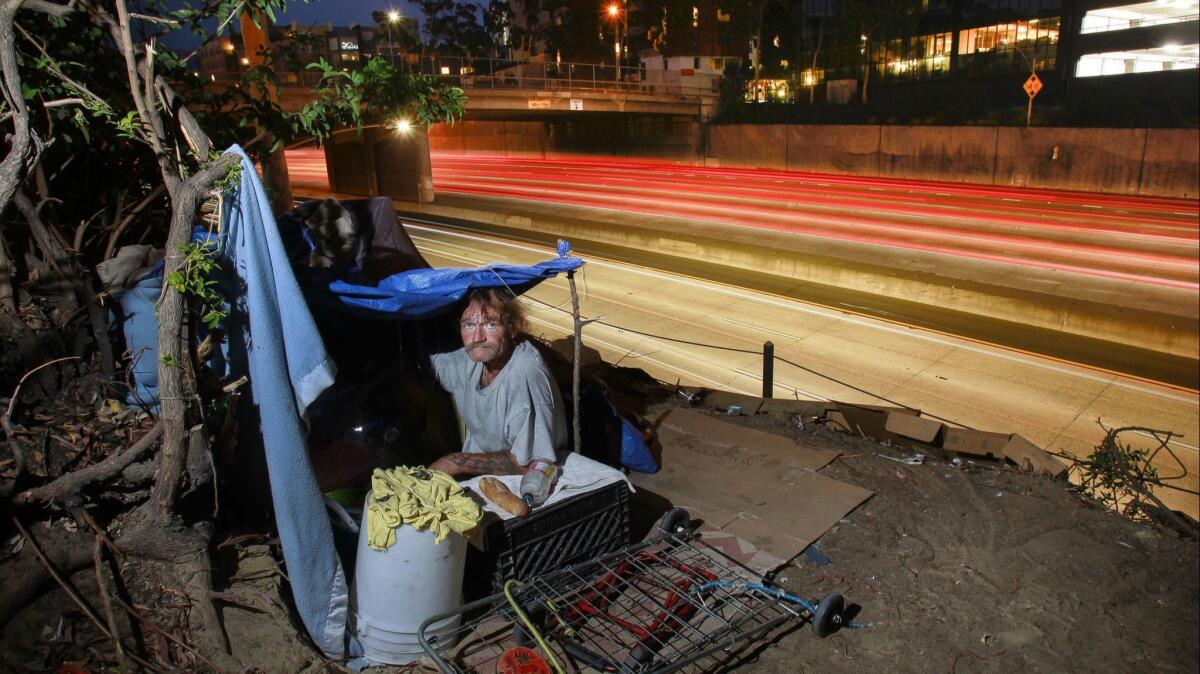
- Share via
San Diego — Downtown San Diego may appear to have fewer homeless people during the day, but the number of people sleeping on sidewalks, in tents and vehicles at night has continued to grow over the past few months.
According to the count by Downtown San Diego Partnership, a nonprofit that advocates for a variety of business groups, 964 unsheltered people were counted downtown in August, including 582 in East Village alone.
That’s 38 more people than were counted in July and 205 more than were counted in June. The population is higher than it was shortly before the city open large tented shelters that took hundreds of people off the street about nine months ago.
The latest number is far from the peak of downtown’s homeless population, which reached a record high of 1,415 in December 2016. Since then, the population has gone up and down over time, dripping to 882 in January 2017 and reaching 1,335 in August of that year.
The downtown homeless population dropped after the tents opened last December and January, but fluctuated over the next few months.
Homeless people in the tents are not included in the Downtown Partnership’s monthly count. If the 475 people inside the two downtown tents were counted, the homeless population in the area would be a record high of 1,439.
The Alpha Project and Father Joe’s Villages operate the two downtown tents while a third is operated by Veterans Village of San Diego on Sports Arena Boulevard.
The tents are known as bridge shelters because they are intended to provide temporary bridge between life on the street and a permanent home.
San Diego City Council members approved funding for the tents last November and set a goal of having 65 percent of the tents’ inhabitants leaving for permanent housing. The hope was that people who left the shelters for housing would be replaced by people living on the street, and the downtown population would begin to drop.
A report on the tents’ progress in June, however, found only 12 percent of people leaving the tent have found permanent housing. It’s unclear where the others went, but homeless advocate Michael McConnell, who opposed the tents, said they most likely just returned to the streets.
The uptick comes at a time when the San Diego Police Department has increased its outreach efforts to homeless people, sometimes working on the street with representatives from nonprofits in an attempt to get people into shelters or connect them with services.
The city also has upped its effort to help the homeless in recent months by opening a second storage center for homeless people to store their possessions. The new center coincided with a new law that prohibits people from leaving items in public places for more than three hours.
Shopping carts, baby carriages and other items often associated with the homeless disappeared from many downtown sidewalks following the new law. The latest data, however, indicates that the homeless people themselves have not.
Angela Wells, director of communications for Downtown San Diego Partnership, said the nonprofit doesn’t speculate on what the numbers mean, but only provides the information to help the community understand the level of homelessness in the neighborhoods.
The counts are taken in the early hours of the last Thursday of each month.
San Diego Regional Task Force on the Homeless CEO Gordon Walker said he had not analyzed the data so had no comment about the increase.
Father Joe’s Villages President and CEO Deacon Jim Vargas she could not speculate about why the population has increased. While the downtown tented shelters haven’t caused the homeless population on the street to decrease, Vargas said they still have provided a necessary function.
“If it weren’t for these bridge shelters, there would be more people on the street,” he said. “It’s proving effective in that regard.”
Vargas said it’s not possible to tell why the downtown homeless population has increased, but he rejects the idea that services such as Father Joe’s are a draw for them.
“I remind people that the services are there because that’s where the homeless are,” he said.
McConnell said he had no clue why the population had increased, but that he knew the tented shelters would not reduce homelessness.
“It appears to me that the city is more focused on reducing the visibility of homelessness rather than reducing homelessness itself,” he said.
The good news is that this year’s monthly average of 874 homeless people downtown is 184 less than the monthly average in 2017 and 199 less than the monthly average in 2016, according to the data provided by the Downtown San Diego Partnership.
The population count from August, however, shows the impact of the city’s tented shelters may have been negated by more homeless people coming downtown.
The Alpha Project opened downtown on Newton Avenue on Dec. 1, with 325 beds, and the Father Joe’s Villages tent opened a 150-bed tent for families and single woman downtown at 14th and Commercial streets in January.
The third tent has 200 beds and was opened Dec. 23 by Veterans Village of San Diego on Sports Arena Boulevard.
Although they were slow to fill, the opening of the tents did appear to have a quick impact on the homeless population. The downtown homeless population was 1,012 in December 2017, and the number dropped by 208 in January.
The annual countywide point-in-time count conducted by the Regional Task Force on the Homeless also found a decrease in many downtown neighborhoods when its count was taken in January.
By February, however, the Downtown Partnership’s count found the population had crept up from 804 to 863. In March, it jumped to 980, the highest monthly count downtown so far this year.
The upward trend isn’t constant, however. The population dripped to 791 in April, rose to 904 in May, then dipped again to 759 in June.
Since then, the downtown population has continued to rise and surpassed some of the monthly counts of 2017, when the population was considered at a crisis level.
San Diego Mayor Kevin Faulconer’s Press Secretary Greg Block said this week that he did not know why the population increased downtown, but the city had no plans to respond by opening a fourth tented shelter.
“Right now we need to focus at doing better at what we’re doing, getting more people through these,” he said about the goal of finding permanent housing for people in the tents. “And we need to build more housing before we invest more in another bridge shelter.”
McConnell has been critical of the city’s approach and argues it should be pursuing more permanent housing opportunities.
“Shelters in and of themselves don’t reduce homelessness,” he said. “It may take some people off the street temporarily, but as more people become homeless, you have tents full and now you have the streets full, and you haven’t accomplished anything. I’ve said this over and over, and now the numbers are bearing that out.”
Monthly counts conducted by the Downtown Partnership do not include interviews with people, so there is no way to know what brought them downtown, how long they had been homeless or whether they are local or from another city or state.
San Diego Padres General Partner Peter Seidler, who pushed for the tented shelters and helped fund their opening, said he also would like to know why the population has increased.
To help get answers, he said he and business owner Dan Shea, who joined him in advocating for the tents, have provided the Regional Task Force on the Homeless with several hundred thousand dollars to improve its Homeless Management Information System, which will help collect data on homeless people in the area.
“I think it’s critical that we have accurate analysis and accurate facts with which to make decisions and conclusions,” he said about the system improvements he expects to be in places in a few months.
Like Vargas, Seidler also defended the three tent shelters because together they help house almost 700 people and link them to services that can lead them out of homelessness.
Besides providing an overall count of homeless people, data from the Downtown Partnership also shows the population rises and drops in different neighborhoods over the months.
The southeast corner of East Village had the largest homeless population in this and in past years. Its highest count was 688 in August 2017 while this year’s peak was 385 in July. The lowest population for the southeast corner this year was 294 in April.
In the Gaslamp Quarter, the population reached a high of 93 in March and dropped to a low of 39 in June.
The Downtown Partnership’s methodology for counting changed in May to match the method used in the annual countywide count by the Regional Task Force on the Homeless. In the change, the number of people assumed to be inside a handmade structure or vehicle shifted by a fraction.
Numbers dipped in most areas following the change, but it’s unclear if that was caused by the new methodology, and the differences were insignificant.
Homeless Playlist

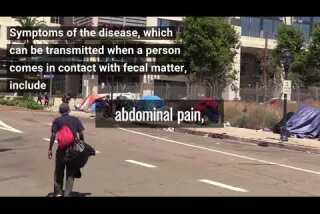
San Diego hepatitis outbreak continues to grow: 481 cases
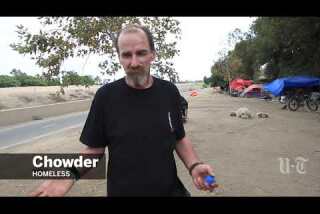
Homeless entrenched in booming tent city along Santa Ana River
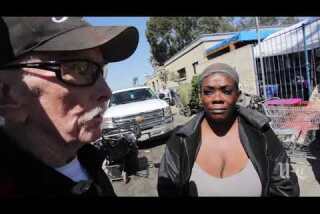
San Diego mayor agreed to homeless hub, then delayed, advocates say

Homeless outreach in San Diego
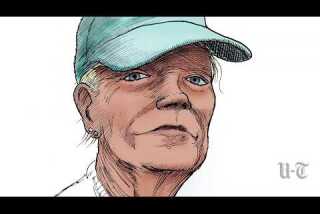
Video: Street Art: Portraits of San Diego's Homeless #8

Street Art: Portraits of San Diego's Homeless #7

Pitching a tent plan for San Diego's homeless

Homeless efforts get $80M boost for various services
760-529-4939
More to Read
Sign up for Essential California
The most important California stories and recommendations in your inbox every morning.
You may occasionally receive promotional content from the Los Angeles Times.










